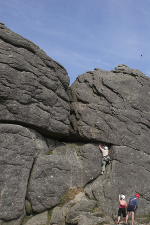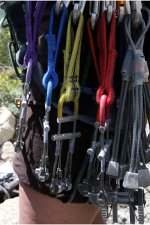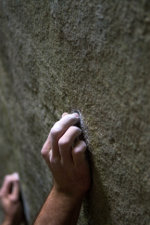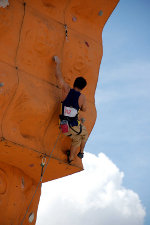Written on
September 26, 2011 by state
Climbing on Private Property Many significant rock outcrops exist on private land. Some people within the rock climbing community have been guilty of trespassing in many cases, often after land ownership transfers and previous access permission is withdrawn. In the U.S. the climbing community responded to access closures by forming the Access Fund. This is…
Continue Reading »
Written on
September 26, 2011 by state
Environmental Impact Although many climbers adhere to “minimal impact” and “leave no trace” practices, rock climbing is sometimes damaging to the environment. Common environmental damages include: soil erosion, chalk accumulation, litter, abandoned bolts and ropes, human excrement, introduction of foreign plants through seeds on shoes and clothing and damage to native plant species, especially those…
Continue Reading »
Written on
September 26, 2011 by state
Free Climbing Free climbing is a type of rock climbing in which the climber uses only hands, feet and other parts of the body to ascend, employing ropes and forms of climbing protection to prevent falls only. In contrast, free soloing uses no aids of any kind for protection or ascent while aid climbing employs…
Continue Reading »
Written on
September 26, 2011 by state
Indigenous Culture Considerations Some areas that are popular for climbing, for example in the US and Australia, are also sacred places for indigenous peoples. Many such indigenous people would prefer that climbers not climb these sacred places and have made this information well-known to climbers. A well known example is the rock formation that Americans…
Continue Reading »
Written on
September 26, 2011 by state
Styles of Rock ClimbingMost of the climbing done in modern times is considered free climbing — climbing using one’s own physical strength, with equipment used solely as protection and not as support—as opposed to aid climbing, the gear-dependent form of climbing that was dominant in the sport’s earlier days. Free climbing is typically divided into…
Continue Reading »
Written on
September 26, 2011 by state
Rock Climbing Basics At its most basic, rock climbing involves climbing a route with one’s own hands and feet and little more than a cushioned bouldering pad in the way of protection. This style of climbing is referred to as bouldering, since the relevant routes are usually found on boulders no more than 10 to…
Continue Reading »
Written on
September 26, 2011 by state
Rock climbing is a sport in which participants climb up or across natural rock formations or artificial rock walls. The goal is to reach the summit of a formation or the endpoint of a pre-defined route without falling. Rock climbing competitions have objectives of completing the route in the quickest possible time or the farthest…
Continue Reading »









